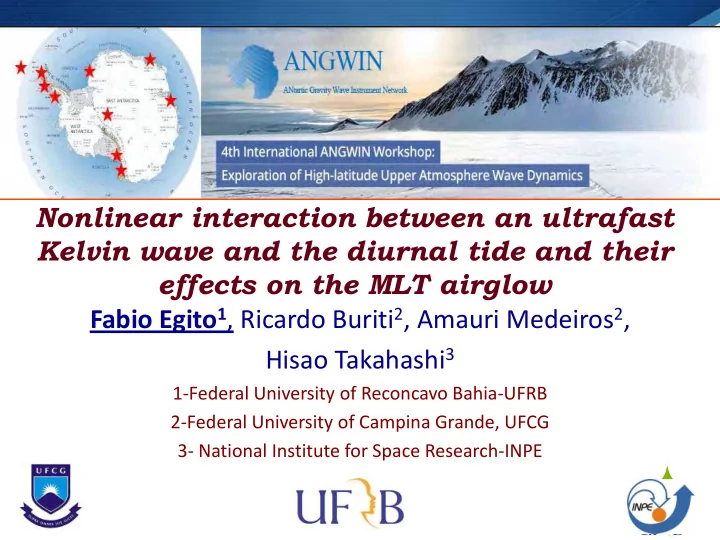

Nonlinear interaction between an ultrafast Kelvin wave and the diurnal tide and their effects on the MLT airglow Fabio Egito 1 , Ricardo Buriti 2 , Amauri Medeiros 2 , Hisao Takahashi 3 1-Federal University of Reconcavo Bahia-UFRB 2-Federal University of Campina Grande, UFCG 3- National Institute for Space Research-INPE S
OUTLINE S Introduction S Nonlinear interaction between tides and planetary waves S Kelvin waves S Instruments and data S Results S The 3-4 day ultrafast Kelvin wave (UFKW) in the wind and airglow S The nonlinear interaction between the UFKW and diurnal tide S Conclusions S Acknowledgements 04/05/2018 2
Introduction S Kelvin waves S Equatorially trapped waves that propagate eastward and present only perturbation in the zonal direction; S Generated in the troposphere by convective activity; S Partially forcing of the well known Intraseasonal (ISO), Semiannual (SAO) and Quasi-biennial (QBO) oscillations (Andrews, 1987; Miyoshi and Fujiwara, 2006) by transporting eastward momentum; S Day-to-day variability of the equatorial ionosphere (e.g. Takahashi et al., 2007; Onohara et al., 2011, England et al., 2012); Vertical Period (days) Horizontal phase speed wavelength Slow Kelvin waves 15-20 20-40 m/s ~ 10 km (SK) Fast Kelvin waves 6-7 50-80 m/s ~ 20 km (FK) 3 Ultrafast Kelvin 3-4 100-120 m/s >40 km waves (UFK)
Introduction S Nonlinear interaction The nonlinear interaction is pathway to short-term variability of the atmospheric tides. When a nonlinear interaction between a tide and planetary wave (PW) takes place (Teitelbaum and Vial, 1991): S The tidal amplitude is modulated at the period of the planetary wave; S Generation of secondary waves with frequencies that are the sum and difference between the frequencies of the primary waves (tide and PW). 04/05/2018 4
Instruments and Data Cariri (7.4 ° S, 36.5 ° W) Photometer Meteor radar Credit: Alisson Carvalho
Instruments and Data S Photometer: nightly measurements of the integrated intensities: S OI557.7nm (green line), O2b(0-1) and OH(6-2) emissions; S OH rotational temperature; Lomb-Scargle analysis
Instruments and Data S Meteor radar S Zonal and meridional winds at: S 82; 85; 88; 91; 94; 98 km S 2h resolution Operating frequency 35.24MHz Peak power 12kw
Results: wind 3-4 day oscillations Zonal wavelet spectrum at 91 km. Meridional wavelet spectrum at 91 km. 04/05/2018 8
Results: wind 3-4 day oscillations S 3-4 day filtered wind Ampl. (m/s) ~ λ v 40km Well known UFKW. Their effects on the MLT and equatorial ionosphere have been addressed in several studies (e.g Phase (days) .Takahashi et al., 2007; Lima et al., 2008; Onohara et al., 2011). 04/05/2018 9
Results: airglow 3-4 day oscillations The case of March 2005 S The UFKW signature well characterized in the OH, O2 and TOH, but not in the OI557.7nm emission; Egito et al., (2018) Normalized Lomb-Scargle periodogram. 10
Results: airglow 3-4 day oscillations S The 3-4 day oscillation in the airglow in March 2005. Why the UFKW signature is not mathematically observed in the OI557.7nm emission? S May be related to the influence of the atmospheric tides 04/05/2018 11
Results: airglow 3-4 day oscillations S OI557.7nm (green line) nightly variation Tides are known for strongly affect the airglow. In the equatorial region the airglow is strongly driven by the diurnal tide specially before midnight (Shepherd et al., 2005) 04/05/2018 12
Results: airglow 3-4 day oscillations S Post midnight data S (00:00 to 05:00LT) S The 3-4 day UFKW signature is well defined in all emissions, including the OI557.7nm. S Short time (few days) variability of the tides may affect the airglow variations associated to the UFKW. S Nonlinear interaction 04/05/2018 13
Results: nonlinear interaction S Generated secondary waves UFKW DT DT Secondary waves Secondary waves Sum and difference between frequencies of the primary waves (tides and PW) 14
Results: nonlinear interaction S Tidal amplitude modulation Amplitude modulation of the diurnal tide in the zonal wind at 3.5-day period. 04/05/2018 15
Results: nonlinear interaction S The 1.3-day secondary wave Downward phase progression: • Upward propagation of energy and momentum • λ v ~ 44 km 04/05/2018 16
Summarizing S We observed the presence of an UFKW in the airglow and neutral wind; S We found indications of the nonlinear interaction between the UFKW and diurnal tide: S The diurnal tide amplitude was found to be modulated by the UFKW; S A 1.3-day secondary wave was observed in the zonal wind and it was found to propagate upward with a relatively long vertical wavelength (~44 km); S The nonlinear interaction, by changing the tidal amplitudes, may have modified the observed airglow variability in the scale of days. 04/05/2018 17
Acknowledgements S We are thankful to the ANGWIN organize committee for providing financial support to our attendance at this workshop. EGITO, F.; BURITI, Ricardo Arlen ; MEDEIROS, A. F. ; TAKAHASHI, H. . Ultrafast Kelvin waves in the MLT airglow and wind, and their interaction with the atmospheric tides. ANNALES GEOPHYSICAE, v. 36, p. 231-241, 2018 . 04/05/2018 18
Recommend
More recommend